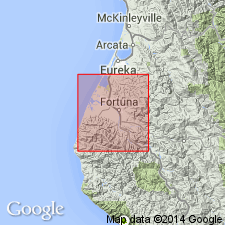- Usage in publication:
-
- [Wildcat] series
- Modifications:
-
- Original reference
- Dominant lithology:
-
- Clay
- Shale
- Sand
- Sandstone
- Conglomerate
- AAPG geologic province:
-
- Eel River basin
Lawson, A.C., 1894, The geomorphogeny of the coast of northern California: University of California, Bulletin of the Department of Geology, v. 1, no. 8, p. 241-272.
Summary:
Pg. 255-263. Wild-cat series. Evenly bedded yellow and brown clays, silty clay shales, sandy clays, argillaceous sands, compact yellow sandstones, and pebbly conglomerates, 4,600 feet thick. Contain Pliocene fossils and are correlated with Merced formation. The region occupied by the terrane is commonly known to the people of Humboldt County as the "Wild-cat Country." Occupies large part of Humboldt County to north of Bear River Ridge and east of Humboldt Bay, and is also doubtless extensively developed in coastal region north of Eureka, northern California.
Source: US geologic names lexicon (USGS Bull. 896, p. 2335).

- Usage in publication:
-
- Wildcat group
- Modifications:
-
- Principle reference
- Dominant lithology:
-
- Mudstone
- Silstone
- Claystone
- Sandstone
- Conglomerate
- AAPG geologic province:
-
- Eel River basin
Summary:
Pg. 13 (fig. 3), 24-26, 44-47, 102, pls. Wildcat series (Lawson, 1894) has become established in literature as loose term for Tertiary sediments (in Humboldt County) of suspected Pliocene age. Term Wildcat group is used here for sediments ranging from upper Miocene to lower Pliocene. Composed principally of slightly indurated mudstone, siltstone, claystone, sandstone, and conglomerate; minor amounts of limestone, tuff, and lignite. Thickness more than 12,000 feet. In Ferndale Hills, on south side of Cenozoic basin, subdivided into (ascending) Pullen, Eel River, Rio Dell, Scotia Bluffs, and Carlotta formations (all new). Northeast of Fortuna, group is undifferentiated. Strong angular unconformity separates group from Yager formation (new) and Franciscan; Hookton formation (new) deposited on eroded surface of Wildcat group. Fossils [listed].
Type locality for group: along Eel River from west of Scotia, Humboldt Co., north to Van Duzen River. Region occupied by terrace is commonly known to people of Humboldt Co. as "Wild-cat Country."
Source: Publication; US geologic names lexicon (USGS Bull. 1200, p. 4233-4234).
For more information, please contact Nancy Stamm, Geologic Names Committee Secretary.
Asterisk (*) indicates published by U.S. Geological Survey authors.
"No current usage" (†) implies that a name has been abandoned or has fallen into disuse. Former usage and, if known, replacement name given in parentheses ( ).
Slash (/) indicates name conflicts with nomenclatural guidelines (CSN, 1933; ACSN, 1961, 1970; NACSN, 1983, 2005, 2021). May be explained within brackets ([ ]).

